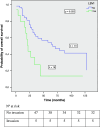Lymphatic and/or blood vessel invasion in gastric cancer: relationship with clinicopathological parameters, biological factors and prognostic significance
- PMID: 17628829
- PMCID: PMC12161670
- DOI: 10.1007/s00432-007-0264-3
Lymphatic and/or blood vessel invasion in gastric cancer: relationship with clinicopathological parameters, biological factors and prognostic significance
Abstract
Background: Lymphatic and/or blood vessel tumoral invasion (LBVI) is a common histopathologic finding of gastric carcinomas, which could make it an additional cost efficient marker and help in the detection of patients at risk for recurrence.
Materials and methods: The subjects of this study were 144 patients with primary gastric adenocarcinoma, who consecutively underwent surgery. LBVI was evaluated by H&E staining and complementary with immunohistochemical staining with anti-CD34. Intratumoral levels of EGFR were analyzed with a radioligand technique, whereas c-erbB-2 and tPA were determined by ELISA methods; pS2, cathepsin D and hyaluronic acid by immunoradiometric assays; and VEGFR-1 and -2 by immunohistochemical assays. The mean follow-up period for these patients was 33.1 months.
Results: LBVI was present in 46 patients (31.9%). The presence of LBVI correlated significantly with tumor stage, lymph node involvement, surgical resectability, histological type and histological grade, being present in a higher percentage among II-IV tumor stage (P = 0.0001), poorly differentiated (P = 0.01), diffuse type (P = 0.009), R1-R2 (P = 0.002) and lymph node-positive (P = 0.005) tumors. In addition, statistical analysis demonstrated that LBVI was significantly associated with a poorer overall patients' survival in the univariate analysis (P = 0.0001) as well as in the multivariate analysis (P = 0.009). However, our results failed to show any significant relationship between LBVI and any of the intratumoral biological parameters studied.
Conclusion: LBVI provides additional useful information that could be applied to identify gastric cancer patients at risk for recurrence, who might be candidates for further adjuvant therapies.
Figures
Similar articles
-
Diagnostic accuracy of endoscopic ultrasonography (EUS) for the preoperative locoregional staging of primary gastric cancer.Cochrane Database Syst Rev. 2015 Feb 6;2015(2):CD009944. doi: 10.1002/14651858.CD009944.pub2. Cochrane Database Syst Rev. 2015. PMID: 25914908 Free PMC article.
-
Overexpression of Grb2/HER2 signaling in Chinese gastric cancer: their relationship with clinicopathological parameters and prognostic significance.J Cancer Res Clin Oncol. 2009 Oct;135(10):1331-9. doi: 10.1007/s00432-009-0574-8. Epub 2009 Apr 1. J Cancer Res Clin Oncol. 2009. PMID: 19337752 Free PMC article.
-
Impact of lymphatic and/or blood vessel invasion in stage II gastric cancer.World J Gastroenterol. 2012 Jul 21;18(27):3610-6. doi: 10.3748/wjg.v18.i27.3610. World J Gastroenterol. 2012. PMID: 22826628 Free PMC article.
-
Morphological predictors of lymph node metastasis in early gastric cancer.BMC Surg. 2025 Jul 4;25(1):287. doi: 10.1186/s12893-025-03019-z. BMC Surg. 2025. PMID: 40616020 Free PMC article.
-
Cost-effectiveness of using prognostic information to select women with breast cancer for adjuvant systemic therapy.Health Technol Assess. 2006 Sep;10(34):iii-iv, ix-xi, 1-204. doi: 10.3310/hta10340. Health Technol Assess. 2006. PMID: 16959170
Cited by
-
Effect of lymphadenectomy extent on advanced gastric cancer located in the cardia and fundus.World J Gastroenterol. 2008 Jul 14;14(26):4216-21. doi: 10.3748/wjg.14.4216. World J Gastroenterol. 2008. PMID: 18636669 Free PMC article.
-
First clinical investigation to predict lymphovascular and/or perineural invasion in gastric cancer using 18F-FAPI-42 PET/CT parameters.Eur J Nucl Med Mol Imaging. 2025 May 19. doi: 10.1007/s00259-025-07325-9. Online ahead of print. Eur J Nucl Med Mol Imaging. 2025. PMID: 40387910
-
Pathological evaluation of gastrointestinal endoscopic submucosal dissection materials based on Japanese guidelines.World J Gastrointest Endosc. 2012 Nov 16;4(11):489-99. doi: 10.4253/wjge.v4.i11.489. World J Gastrointest Endosc. 2012. PMID: 23189220 Free PMC article.
-
Proteomic analysis on N, N'-dinitrosopiperazine-mediated metastasis of nasopharyngeal carcinoma 6-10B cells.BMC Biochem. 2012 Nov 19;13:25. doi: 10.1186/1471-2091-13-25. BMC Biochem. 2012. Retraction in: BMC Mol Cell Biol. 2022 Apr 19;23(1):20. doi: 10.1186/s12860-022-00419-4. PMID: 23157228 Free PMC article. Retracted.
-
Lymphatic vascular invasion is an independent correlated factor for lymph node metastasis and the prognosis of resectable T2 gastric cancer patients.Tumour Biol. 2013 Apr;34(2):1005-12. doi: 10.1007/s13277-012-0637-3. Epub 2013 Jan 6. Tumour Biol. 2013. PMID: 23292920
References
-
- Becker KF, Keller G, Hoefler H (2000) The use of molecular biology in diagnosis and prognosis of gastric cancer. Surg Oncol 9:5–11 - PubMed
-
- Boring CC, Squires TS, Tong T (1993) Cancer statistics, 1993. CA Cancer J Clin 43:7–26 - PubMed
-
- Bradford MM (1976) A rapid and sensitive method for the quantitation of microgram quantities of protein utilizing the principle of protein-dye binding. Anal Biochem 72:248–254 - PubMed
-
- Carmeliet P (2000) Mechanisms of angiogenesis and arteriogenesis. Nat Med 6:389–395 - PubMed
Publication types
MeSH terms
Substances
LinkOut - more resources
Full Text Sources
Medical
Research Materials
Miscellaneous



